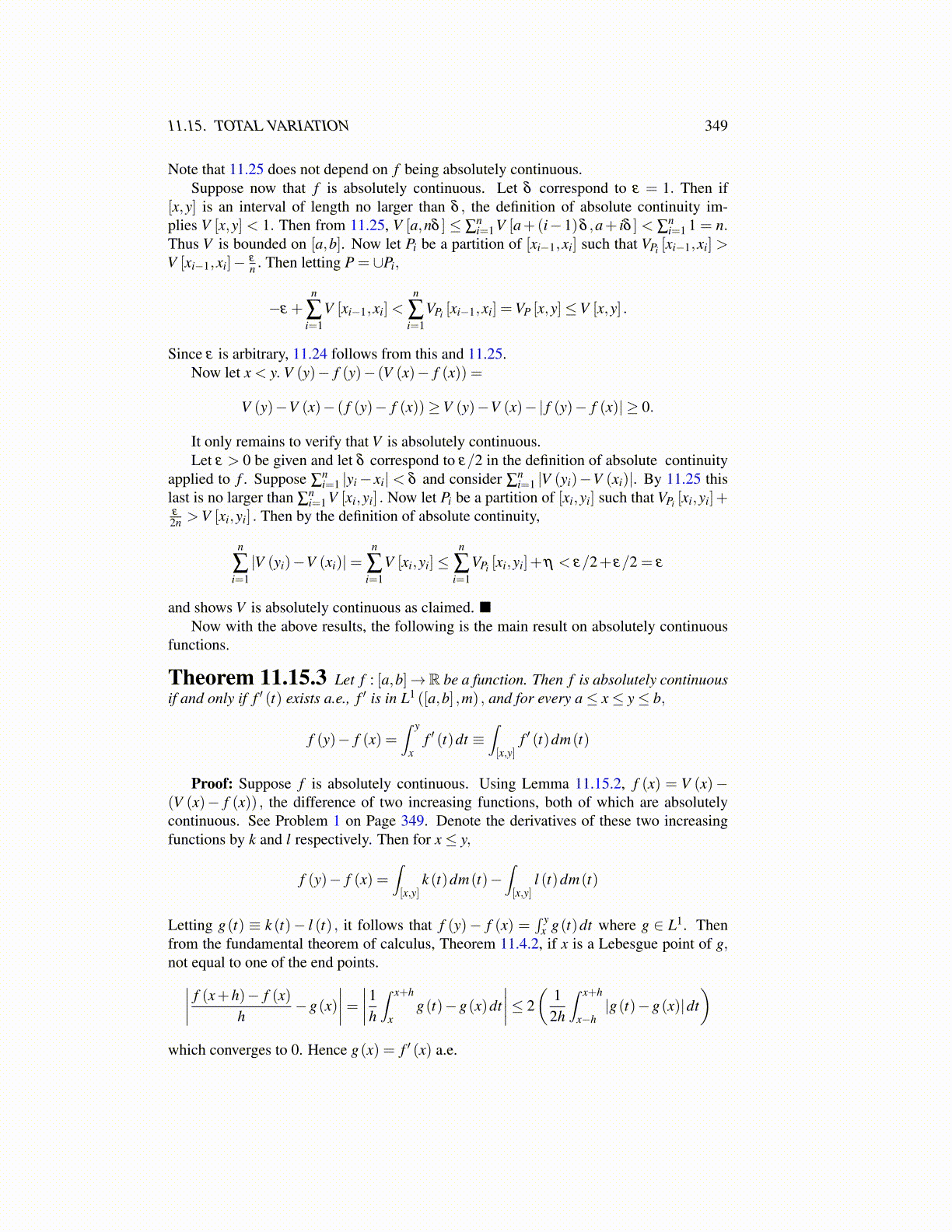
11.15. TOTAL VARIATION 349
Note that 11.25 does not depend on f being absolutely continuous.Suppose now that f is absolutely continuous. Let δ correspond to ε = 1. Then if
[x,y] is an interval of length no larger than δ , the definition of absolute continuity im-plies V [x,y] < 1. Then from 11.25, V [a,nδ ] ≤ ∑
ni=1 V [a+(i−1)δ ,a+ iδ ] < ∑
ni=1 1 = n.
Thus V is bounded on [a,b]. Now let Pi be a partition of [xi−1,xi] such that VPi [xi−1,xi] >V [xi−1,xi]− ε
n . Then letting P = ∪Pi,
−ε +n
∑i=1
V [xi−1,xi]<n
∑i=1
VPi [xi−1,xi] =VP [x,y]≤V [x,y] .
Since ε is arbitrary, 11.24 follows from this and 11.25.Now let x < y. V (y)− f (y)− (V (x)− f (x)) =
V (y)−V (x)− ( f (y)− f (x))≥V (y)−V (x)−| f (y)− f (x)| ≥ 0.
It only remains to verify that V is absolutely continuous.Let ε > 0 be given and let δ correspond to ε/2 in the definition of absolute continuity
applied to f . Suppose ∑ni=1 |yi− xi| < δ and consider ∑
ni=1 |V (yi)−V (xi)|. By 11.25 this
last is no larger than ∑ni=1 V [xi,yi] . Now let Pi be a partition of [xi,yi] such that VPi [xi,yi]+
ε
2n >V [xi,yi] . Then by the definition of absolute continuity,
n
∑i=1|V (yi)−V (xi)|=
n
∑i=1
V [xi,yi]≤n
∑i=1
VPi [xi,yi]+η < ε/2+ ε/2 = ε
and shows V is absolutely continuous as claimed. ■Now with the above results, the following is the main result on absolutely continuous
functions.
Theorem 11.15.3 Let f : [a,b]→R be a function. Then f is absolutely continuousif and only if f ′ (t) exists a.e., f ′ is in L1 ([a,b] ,m) , and for every a≤ x≤ y≤ b,
f (y)− f (x) =∫ y
xf ′ (t)dt ≡
∫[x,y]
f ′ (t)dm(t)
Proof: Suppose f is absolutely continuous. Using Lemma 11.15.2, f (x) = V (x)−(V (x)− f (x)) , the difference of two increasing functions, both of which are absolutelycontinuous. See Problem 1 on Page 349. Denote the derivatives of these two increasingfunctions by k and l respectively. Then for x≤ y,
f (y)− f (x) =∫[x,y]
k (t)dm(t)−∫[x,y]
l (t)dm(t)
Letting g(t) ≡ k (t)− l (t) , it follows that f (y)− f (x) =∫ y
x g(t)dt where g ∈ L1. Thenfrom the fundamental theorem of calculus, Theorem 11.4.2, if x is a Lebesgue point of g,not equal to one of the end points.∣∣∣∣ f (x+h)− f (x)
h−g(x)
∣∣∣∣= ∣∣∣∣1h∫ x+h
xg(t)−g(x)dt
∣∣∣∣≤ 2(
12h
∫ x+h
x−h|g(t)−g(x)|dt
)which converges to 0. Hence g(x) = f ′ (x) a.e.